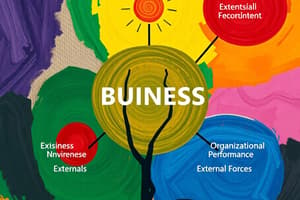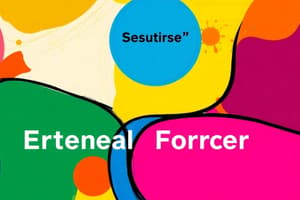Podcast
Questions and Answers
Which factor is not part of the general environment that affects organizations?
Which factor is not part of the general environment that affects organizations?
- Technological factors
- Political factors
- Vendor relationships (correct)
- Socio-cultural factors
What describes a high degree of environmental uncertainty?
What describes a high degree of environmental uncertainty?
- A predictable economic environment with low inflation
- Frequent changes in technology and a complex market (correct)
- A consistent demographic profile in the population
- Stable political conditions with few changes
Which of the following is considered a technological factor in the general environment?
Which of the following is considered a technological factor in the general environment?
- Interest rates
- Cultural attitudes towards sustainability
- Presence of advanced transportation infrastructure (correct)
- Government regulations on employment protection
Which demographic characteristic is not typically included in the analysis of the general environment?
Which demographic characteristic is not typically included in the analysis of the general environment?
The competitive environment specifically includes which of the following?
The competitive environment specifically includes which of the following?
Which statement accurately reflects the relationship between legal and political factors in the general environment?
Which statement accurately reflects the relationship between legal and political factors in the general environment?
What best defines the international aspect of the general environment?
What best defines the international aspect of the general environment?
Which environmental factor relates to the sustainability practices of an organization?
Which environmental factor relates to the sustainability practices of an organization?
What is the primary impact of high rivalry among competitors in an industry?
What is the primary impact of high rivalry among competitors in an industry?
Which factor increases the threat of new entrants into an industry?
Which factor increases the threat of new entrants into an industry?
What characterizes a strong organizational culture?
What characterizes a strong organizational culture?
Which of the following represents the invisible components of organizational culture?
Which of the following represents the invisible components of organizational culture?
In terms of stakeholders, what is expected of suppliers?
In terms of stakeholders, what is expected of suppliers?
Which dimension of organizational culture emphasizes the importance of teamwork?
Which dimension of organizational culture emphasizes the importance of teamwork?
What is a significant effect of high bargaining power of buyers?
What is a significant effect of high bargaining power of buyers?
What aspect of organizational culture is highlighted by adaptability?
What aspect of organizational culture is highlighted by adaptability?
Which of the following best describes external stakeholders?
Which of the following best describes external stakeholders?
What can weaken an organization's culture?
What can weaken an organization's culture?
Which aspect is NOT considered a factor in the bargaining power of suppliers?
Which aspect is NOT considered a factor in the bargaining power of suppliers?
What practice can help maintain an organization’s culture once it is established?
What practice can help maintain an organization’s culture once it is established?
What is a key characteristic of the threats posed by substitute products?
What is a key characteristic of the threats posed by substitute products?
Which of the following best captures the essence of a weak organizational culture?
Which of the following best captures the essence of a weak organizational culture?
Flashcards
Business Environment
Business Environment
External factors that can influence an organization's performance, such as political, economic, social, technological, environmental, and legal forces.
Environmental Uncertainty
Environmental Uncertainty
The degree to which change and complexity exist in an organization's environment.
Degree of Change
Degree of Change
The frequency of changes in the components of the environment.
Complexity
Complexity
Signup and view all the flashcards
General Environment
General Environment
Signup and view all the flashcards
Competitive Environment
Competitive Environment
Signup and view all the flashcards
PESTEL Analysis
PESTEL Analysis
Signup and view all the flashcards
Economic Forces
Economic Forces
Signup and view all the flashcards
Porter's Five Forces Model
Porter's Five Forces Model
Signup and view all the flashcards
Rivalry Among Competitors
Rivalry Among Competitors
Signup and view all the flashcards
Threat of New Entrants
Threat of New Entrants
Signup and view all the flashcards
Bargaining Power of Suppliers
Bargaining Power of Suppliers
Signup and view all the flashcards
Bargaining Power of Buyers
Bargaining Power of Buyers
Signup and view all the flashcards
Threat of Substitutes
Threat of Substitutes
Signup and view all the flashcards
Organizational Culture
Organizational Culture
Signup and view all the flashcards
Strong Culture
Strong Culture
Signup and view all the flashcards
Weak Culture
Weak Culture
Signup and view all the flashcards
Visible Artefacts
Visible Artefacts
Signup and view all the flashcards
Invisible Culture
Invisible Culture
Signup and view all the flashcards
Stakeholders
Stakeholders
Signup and view all the flashcards
External Stakeholders
External Stakeholders
Signup and view all the flashcards
Internal Stakeholders
Internal Stakeholders
Signup and view all the flashcards
Study Notes
Business Environment
- Environment encompasses external institutions influencing an organization's performance.
- Environmental uncertainty: Degree of change and complexity impacting an organization.
- Degree of change: Frequency of components' alterations.
- Complexity: Number of components and knowledge about them.
General Environment
- General environment affects all organizations, including:
- Political, economical, socio-cultural, technological, environmental, and legal factors.
- Major forces within the general environment:
- Economic: Rates, inflation, unemployment, growth.
- Technological: Infrastructure, industrial innovations, advancements in production/distribution.
- Political and legal: Political climate, regulations, and legal changes.
- Socio-cultural: Customs, values, lifestyles, behaviors.
- Demographic: Characteristics of population (age, gender, etc.).
- Environmental: Pollution, sustainable energy, climate change.
- International: Involvement in, or impact from, international business.
- International PESTEL Analysis:
- Political: Government attitudes to foreign investment, political stability, and IP policy.
- Economic: Growth rate, wealth distribution, currency stability, and exchange rates.
- Socio-cultural: National cultures, attitudes to foreign companies and staff.
- Technological: Telecommunications, power supply, import/export infrastructure.
- Environmental: Natural resources, environmental quality, and climate change effects.
- Legal: Tariff policies, trade pacts, employment protection, company taxes.
Competitive Environment
- Competitive environment: Forces from suppliers, distributors, customers, and competitors affecting inputs/outputs.
- Suppliers: Provide input resources, receive payment.
- Distributors: Help organizations sell to customers.
- Customers: Individuals/groups purchasing goods/services.
- Competitors: Organizations producing similar goods/services.
Porter's Five Forces Model
- Analyzing industry attractiveness.
- Rivalry among competitors: Higher rivalry, lower profits.
- Number of competitors, demand growth, product differentiation, barriers to exit.
- Threat of new entrants: Lower barriers = lower profits.
- Barriers to entry: Capital investment, economies of scale, licenses, customer loyalty.
- Bargaining power of suppliers: Higher power, lower profits.
- Number of suppliers, customer type, supplier expansion, supplier cost to switch.
- Bargaining power of buyers: Higher power, lower profits.
- Threat of substitutes: Similar products from other industries.
Organizational Culture
- Organizational culture: Shared values, principles, traditions, influencing behaviors.
- Strong culture: Shared values, employee identification with culture.
- Weak culture: Values limited to top management, employees do not identify with it.
- Levels of organizational culture:
- Visible artifacts: Dress, behavior, symbols, ceremonies, office layout.
- Invisible: Values and beliefs (interpreted from language, symbols, stories), underlying assumptions and deep beliefs (role modeling, legends, nicknames).
Organizational culture dimensions:
- Adaptability, attention to detail, outcome orientation, people orientation, team orientation, and integrity.
How culture is established
- Founders' vision.
- Transmission through stories, symbols, and language.
- Maintenance through employee selection, socialization, and top managers' actions.
Stakeholders
- Stakeholders: Individuals/groups with interest/claims/stake in a company.
- External Stakeholders: Customers, suppliers, creditors, governments, unions, communities, general public.
- Internal Stakeholders: Stockholders, employees, managers, executives, board members.
- Stakeholder Claims:
- Stockholders: Maximize return on investment.
- Managers: Decide on goals benefiting stakeholders.
- Employees: Performance-based rewards.
- Suppliers: Fair payment and promptness.
- Distributors: Quality products, agreed-upon prices.
- Customers: Attraction for company survival.
- Community: Physical/social infrastructure for operations.
Studying That Suits You
Use AI to generate personalized quizzes and flashcards to suit your learning preferences.




